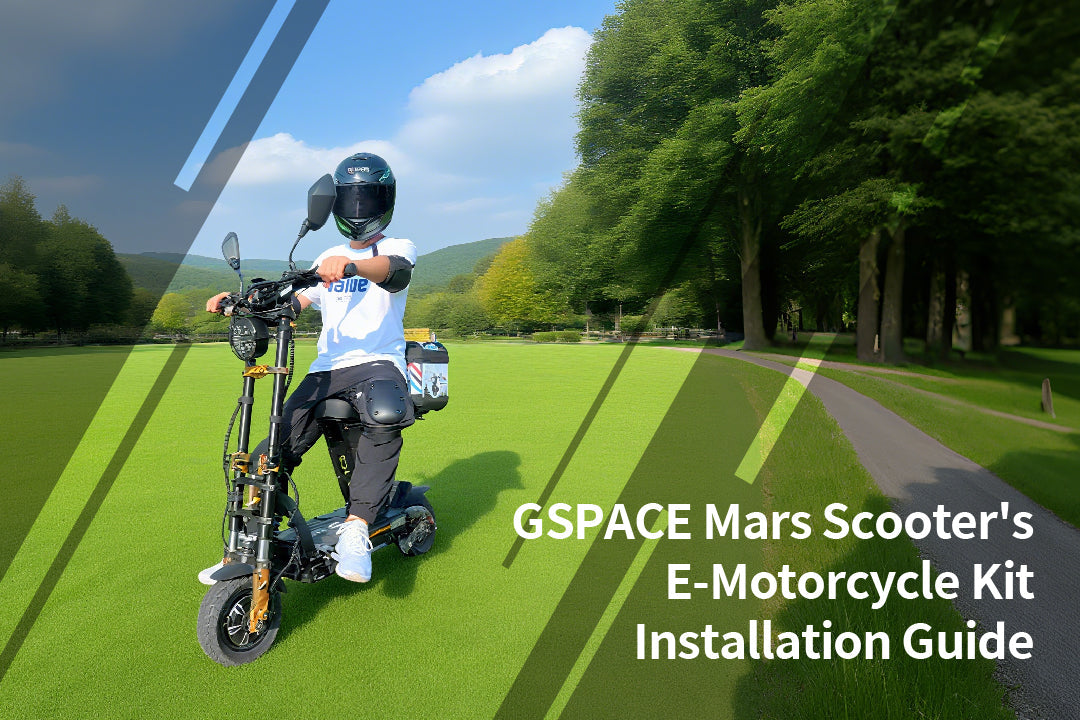Battery Safety in Electric Scooters: Technologies, Risks, and Fire Prevention

Recent headlines about e-scooter fires have sparked widespread concern. Videos of scooters engulfed in flames, often linked to lithium-ion battery failures, raise a critical question: Why do these incidents happen, and how can we prevent them? Let’s break down the science, causes, and solutions to keep your rides safe—especially for premium models like the GSPACE Mars GTR/GT/ECO.

The Basics: How Lithium-Ion Batteries Work
Lithium-ion batteries are the powerhouse behind most e-scooters, including the GSPACE Mars GTR/GT/ECO, and their dominance stems from a unique blend of high energy density, low self-discharge, and rechargeability. To understand their vulnerability, it’s essential to dive into their internal mechanics.
At the heart of every lithium-ion battery lies a closed system consisting of three key components: a cathode (positive electrode, typically made of lithium metal oxides like LiCoO₂ or LiFePO₄), an anode (negative electrode, usually graphite), and an electrolyte (a conductive liquid or gel that facilitates ion movement). A thin, porous separator keeps the cathode and anode physically apart to prevent short circuits while allowing lithium ions to pass through.
During discharging (when the e-scooter is in use), lithium ions detach from the anode, travel through the electrolyte, and embed themselves in the cathode. This movement of ions generates an electric current that powers the scooter’s motor. When charging, the process reverses: an external current forces ions to migrate back to the anode, where they are stored until the next use.
This cycle is highly efficient, but it operates within strict parameters. The electrolyte is flammable, and the ions’ movement generates heat—normally dissipated harmlessly. However, any disruption to this balance (such as a damaged separator, overvoltage, or extreme temperatures) can trigger uncontrolled reactions, making the battery a potential fire hazard.
Why Do E-Scooter Batteries Catch Fire?
Battery fires rarely happen randomly. They’re typically triggered by external factors or internal flaws:
External Factors:
- Using non-original chargers (which can deliver unstable voltage).
- Physical damage (e.g., collisions, punctures, or crushing the battery pack).
- Extreme temperatures (leaving scooters in direct sunlight on 90°F days or exposing them to freezing conditions).
- Overcharging (leaving batteries plugged in overnight, pushing them beyond safe voltage limits).
Internal Factors:
- Manufacturing defects (e.g., faulty separators between electrodes, which can cause short circuits).
- Aging (after 2–3 years or 500+ charge cycles, batteries degrade, increasing internal resistance).
- Internal short circuits (caused by worn materials or tiny metal particles inside the battery).
In both cases, the result can be thermal runaway—a chain reaction where rising temperatures trigger more heat, releasing flammable gases and, eventually, fire.
Corresponding Solutions to Fire Causes
Solutions for External Factors
- Use Original Chargers Only: Always stick to the charger provided by the e-scooter manufacturer. These chargers are specifically designed to match the battery's voltage and current requirements, ensuring stable and safe charging—critical for models like the GSPACE Mars GTR/GT/ECO with advanced battery management systems.
- Avoid Physical Damage: Be cautious while riding to prevent collisions or falls that could damage the battery pack. When storing or transporting the scooter, ensure the battery area is not crushed or punctured.
- Control Temperature Exposure: Never leave the e-scooter in extreme temperatures. Park it in shaded areas on hot days and bring it indoors during freezing weather. Avoid charging the battery in environments where the temperature is too high or too low.
- Prevent Overcharging: Set a timer when charging to avoid leaving the battery plugged in overnight. Most e-scooters have indicators that show when the battery is fully charged, so unplug it promptly once fully charged.
Solutions for Internal Factors
- Choose Reputable Brands: Opt for e-scooters from well-known and reputable manufacturers. These brands usually have strict quality control processes during production, reducing the risk of manufacturing defects.
- Replace Aged Batteries: Keep track of the battery's usage time and charge cycles. If the scooter is 2–3 years old or has gone through 500+ charge cycles, consider replacing the battery with a new one from the manufacturer to avoid issues caused by aging.
- Regular Professional Inspections: Have the e-scooter inspected by professional technicians regularly. They can check for internal short circuits caused by worn materials or tiny metal particles and address potential problems before they lead to fires.
The Solution: GSPACE’s Protection Plan
Preventing battery fires requires proactive protection. That’s where GSPACE’s battery safety enclosure comes in—protecting your safety with six layers of defense designed to stop issues before they start. Thanks to these rigorous safeguards, we’re proud to report zero safety incidents to date across all GSPACE Mars GTR/GT/ECO models.
Our Mars series all feature IP66 water resistance, adding an extra layer of durability by keeping dust and powerful jets of water at bay—critical for protecting the battery and electrical components in harsh weather or wet conditions.
GSPACE batteries are equipped with high-quality components sourced from two renowned manufacturers. Samsung, a global electronics leader, provides key battery parts. Their technology, used in products like the Galaxy S series, ensures stable performance and high energy density in GSPACE batteries. DMEGC, well-respected for its high-precision magnetic materials and components across various industries, also contributes to GSPACE batteries, enhancing their overall reliability—giving users peace of mind through strict adherence to safety, performance, and environmental criteria.
The six-layer protection details are as follows:

- Intelligent BMS: A built-in Battery Management System monitors voltage, current, and temperature in real time. It adjusts charging/discharging to prevent overloads and extends battery life by 30%—all while flagging early warning signs.
- Active Charging Protection: If the charger detects unstable currents or temperatures spiking above safe levels (typically 45°C), it automatically cuts power. No more risky overcharging.
- Efficient Heat Dissipation: A high-performance thermal pad (3W/m·K) conducts heat away from core components, improving cooling efficiency by 25%. This eliminates “hotspots” that could ignite thermal runaway.
- Surge Resistance: Reinforced power connections withstand sudden current surges (common during startup or power fluctuations), reducing wear and tear on critical parts.
- Explosion-Proof Valve: Sealed against water and dust, this valve balances internal pressure. If gases build up, it releases them gradually—lowering the risk of explosive ruptures.
- Fire Suppression: A built-in aerosol extinguisher activates instantly when temperatures hit 170°C. It smothers flames and halts thermal runaway in its tracks.
See It in Action: Our Fire Suppression Test Video
Words matter, but seeing is believing. Our fire suppression test video shows the system in action: when a controlled heat source pushes the battery past 170°C, the aerosol extinguisher triggers within seconds, containing the issue before it escalates. It’s proof that these protections aren’t just theoretical—they work, safeguarding premium models like the GSPACE Mars GTR/GT/ECO.
Maintenance Tips to Boost Safety
Even the best systems need care. Follow these steps to keep your battery healthy—especially for high-performance models like the GSPACE Mars GTR/GT/ECO:
- Stick to Original Chargers: Third-party chargers often lack safety controls. Use only the one provided by your e-scooter manufacturer.
- Inspect Regularly: Check the battery enclosure for cracks, leaks, or bulges. If you notice odd smells or overheating during use, stop riding and contact a professional.
- Avoid Extremes: Don’t leave your scooter in direct sunlight (over 40°C) or freezing cold (below 0°C). Store it in a cool, dry place, and never charge it near flammable materials.
Final Thoughts
E-scooter battery fires are preventable. By understanding the risks—external damage, internal flaws, and improper use—and taking corresponding solutions, as well as investing in systems like GSPACE’s 6-layer protection found in the Mars GTR/GT/ECO series, we can enjoy the convenience of e-scooters without compromise. Pair that with regular maintenance, and you’re not just riding safely—you’re riding smart.
Stay charged, stay safe.




